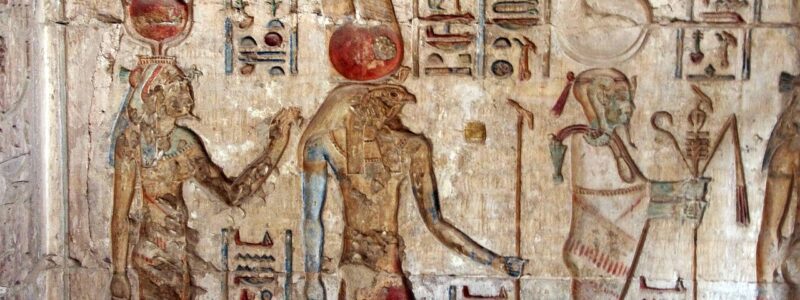Proving the Resurrection
Proving the Resurrection
Proving the Resurrection beyond a reasonable doubt using extra-Biblical sources would be very important. One of the charges against traditional Christianity is that miracles, particularly the Resurrection, are impossible.
Who was Christ? Can Christ be found outside the Bible? Is it possible to show Christ was the Son of God without a reasonable doubt using historical evidence alone?
In short, is it possible to prove that Christ, as portrayed in the Bible, existed without using Scripture? Even more importantly, is it possible to show that he, “beyond a reasonable doubt,” arose from the grave, appeared to numerous witnesses, and then changed the course of history? Proving the Resurrection allows to do just that.
Proving the Biblical Christ using evidence outside the Bible would seem a daunting challenge. There is no evidence that his body was even found. Christ’s body would disprove the Resurrection, and Christianity would be proven false.
Yet, prosecutors convict murderers all the time without a body and circumstantial evidence. They can often make a conviction beyond a reasonable doubt with other evidence associated with the crime.
Proving the Resurrection without a Body
Police are faced with similar challenges all the time. There is no historical evidence that Christ’s body was found after the Resurrection. At first glance, it would seem there could be no way to prove or disprove the Resurrection beyond a reasonable doubt without a body. Police face similar difficulties when trying to convict a murderer without a body. They must prove to a jury that the defendant killed the victim without a reasonable doubt using other evidence. Prosecutors have to convince the jury of murder without even knowing with certainty that the victim is dead.
It will be our challenge here to do something similar with Christ. We will attempt to prove beyond a reasonable doubt that the Biblical Christ existed, that he died and was buried, and – most importantly – that he rose from his tomb after death. We will attempt to show that the most important event in history occurred with all the important implications that follow. We will show how proving the Resurrection is not a pipedream, but it can be done beyond a reasonable doubt.
The importance of this challenge can hardly be overstated. If we can prove the Biblical Christ beyond a reasonable doubt using sources outside Scripture, then everything he said and did is important. This new way of viewing Scripture through accumulating circumstantial evidence from ancient history would destroy liberal theology.
Liberal Theology and Proving the Resurrection
Skepticism Concerning the Historicity of the Resurrection
But what about the skeptics? Throughout the last twenty centuries, there has been no lack of cynics concerning the divinity of Christ, and especially of the Resurrection.
Liberal theology considers Scripture as being the work of men. It is filled with fables and myths like any other religion. The Greek and Roman gods interfered with historical events just like Christ. Why should we consider the Christian God as being any different from these mythological beings?
Liberal theologians specifically deny the Torah was written by Moses but insist it was a much later work by scribes seeking to glorify ancient Israel. They deny the parting of the Red Sea, the wanderings in the Wilderness, Adam and Eve, the Tower of Babel, and even the captivity of a Jewish population in Egypt.
They view any prophecies which may have come true as being written after the event by self-serving scribes. In their view, there is no way ancient prophets could know the future. They view these “prophecies” as too vague, like other “prophets” such as Nostradamus or Jeanne Dixon.
Authorship of Scripture
Liberal theology insists one man did not write Isaiah, but it was composed by multiple authors. Liberal scholars divide the Book of Isaiah into three distinct sections: Proto-Isaiah, Deutero-Isaiah, and Trito-Isaiah. The works of these three separate authors were later combined into the book found in Scripture today. A similar interpretation is applied to other books of Scripture, implying its lack of divine authorship.
Liberal theology considers Scripture as little more than a nice storybook filled with mythological stories from ancient civilizations that passed into obscurity centuries ago. There was no Adam and Eve, no creation out of nothing or ex nihilo, no Flood, no King David or Solomon, none of the prophets are real people, and few of these events occurred.
Skepticism and David Hume
The eighteenth-century skeptic, David Hume, could serve as a representative of doubting miracles in general, and especially the Resurrection. He noted,
When anyone tells me, that he saw a dead man restored to life, I immediately consider with myself, whether it be more probable, that this person should either deceive or be deceived, or that the fact, which he relates, should relly have happened. I weigh the one miracle against the other, and according to the superiority, which I discover, I pronounce my decision, and always reject the greater miracle. If the falsehood or his testimony would be more miraculous, than the event which he relates, then, and not till then, can he pretend to command my belief or opinion.
Hume proposes that if somebody believes in a miracle, he is either lying or has been deceived. If the probability of a miracle is less than the probability of people being deceived, then the miracle must be rejected. This appeal to the most likely explanation is termed abductive reasoning and seems very logical.
Naturally, Hume believed the probability of people being deceived is greater than the probability of the Resurrection is an actual historical event, so he rejects Christianity. Archaeology knows a lot more about ancient history than it knew centuries ago when Hume was alive. This newly acquired understanding can now reasonably challenge Hume’s assertion concerning the probability of the Resurrection.
The Evidence for Proving the Resurrection
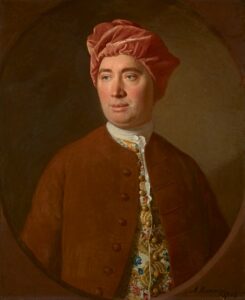
By Allan Ramsay – https://www.nationalgalleries.org/art-and-artists/60610/david-hume-1711-1776-historian-and-philosopher-1754, Public Domain, Link
Is David Hume being fair in his assessment of the facts, or is he rushing to a pre-determined conclusion? Nowhere in his works does he evaluate any of the evidence we will present. One reason for this obvious omission is that much of this evidence was unknown several centuries ago.
The problem with centuries-old historical events is that all the direct witnesses have died, most of the primary evidence is lost, and much of the existing evidence is fragmentary. Scholars argue over whether the evidence might have been altered by over-exuberant protagonists of one side or another. Fabrication of ancient historical events becomes a serious issue. We have only to consider the obvious fabricated ancient epigraphical gospels such as the Gospel of Thomas or the Gospel of Mary
Liberal Theology
Liberal theology defines the work of the Church as its primary responsibility, while creeds, miracles, and many orthodox beliefs were discarded. Critics of liberal theology say that churches have become little more than social clubs or a charity.
Liberal theology originates from the Enlightenment, which asserted a belief in the natural, visible world while discarding any relevance of an unseen world. The only relevant knowledge is that which can be verified through scientific inquiry, which, they say, traditional Christian beliefs can not.
Liberal theology became directly opposed to traditional Christianity, which believed in the Christ of the Scriptures. Traditional Christians defined certain orthodox, non-negotiable beliefs that liberal theology rejects. Over time, liberal theology has become the prevailing attitude of American culture.
The Enlightenment
The European Enlightenment (1660-1789) redefined what it meant to be a Christian. Traditional Christianity, as defined over the past two millennia, defined itself through creeds and confessions based on the authority of Scripture.
Traditional Christians believed in God through Scripture and the Creeds, which articulated a certain worldview and constituted the basis for a good life. Liberal theology, on the other hand, insisted traditional theology was outmoded and unsubstantiated, lacking verifiability, and must be discarded for authentic Christianity to survive.
Without modification of its belief system, liberal theologians believed traditional Christianity would become increasingly irrelevant in the modern world. They insisted that belief in miracles, prophecies, and visions was merely a relic of a superstitious bygone age. Modern liberal Christianity would redefine its beliefs and replace the outmoded worldview of traditional Christianity with a sustainable modern version.
Reinterpretation of Scripture
One way liberal theology has attacked traditional Christianity is through a direct assault upon the authority of Scripture. While Christianity has believed in the inerrancy of Scripture, liberal theologians have tried to tear it apart, rendering it into little more than a series of myths and legends. The Resurrection was considered a myth, as other explanations seem more likely. Proving the Resurrection did not seem like a possibility.
Scripture held a high place in traditional Christianity. It was considered divinely inspired and authoritative in his theological and historical context. Liberal theologians have challenged this view by applying hermeneutical tools to reinterpret ancient literature. Higher critical methods used secular reason to evaluate authorship and dates of composition to question traditional interpretation.
Immanuel Kant
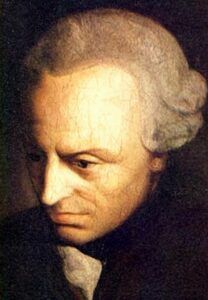
Immanuel Kant
Kant lived at roughly the same time as Hume and developed a philosophy that would have made Hume smile. Kant developed a philosophical understanding of reality that made mankind autonomous in determining reality. He proposed a motto for the Enlightenment – “Dare to Reason” – which he believed would free mankind from superstitions and unprovable beliefs. Christianity was one of these unprovable belief systems that Kant sought to modify. He asserted that proving the Resurrection is impossible because there are other much more likely explanations.
Kant proposed that only what can be proven or learned through the scientific method qualified as knowledge. He asserted that much of traditional Christianity was based upon the authority of Scripture or the traditional interpretation of learned men rather than verifiable knowledge. This would drive a wedge between faith and science, which is still a part of a continuing dialog.
Some of Kant’s philosophic ideas are listed here,
- being “born again” is not the regenerative work of the Holy Spirit but an act of human will that directs mankind to do good rather than evil,
- Jesus’ divinity was not that he was the “Son of God,” but rather an archetype of moral good work
- Jesus’ work was not a substitutionary atone for the sins of mankind because sin is redefined as personal rather than societal
- Sin is the evil intention of the individual that can not be atoned by somebody else, but the personal self can only atone for it.
German Scholarship
Building upon Kant’s philosophy, German universities took over the implementation of Enlightenment thought.
They proposed that human knowledge in all fields of science was a work in progress, advancing truth without resorting to any supernatural worldview. Ultimate or objective truth did not exist. Christianity was not an objective belief system but a continuously developing way of life.
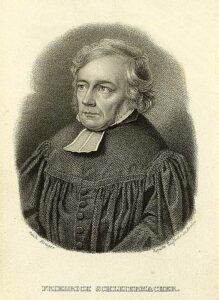
Friedrich Schleiermacher
One of the earliest proponents of a new Christianity was Friedrich Schleiermacher, a founder of the University of Berlin who became the “father of liberal theology.” His book The Christian Faith (1821) proposed a complete reordering of Christianity. Instead of a historic Fall in mankind’s beginning, all people possess God-consciousness and God-forgetfulness. Jesus’ proposed “divinity” was merely an acute sense of God-consciousness.
He also constructed ministerial education. He instituted new hermeneutical methods, which replaced the historical-grammatical method. Rather than the ministry being a spiritual calling requiring the evidence of piety and being “set apart,” he proposed the ministry as merely a “profession” requiring the ministers to be community leaders.
American Scholarship
The restructuring of Christianity into a philosophy rather than an ancient religious tradition spread throughout America during the twentieth century. Calvinism declined in its influence in various Protestant churches. Revivalists explicitly discarded the Calvinist theology that had been so important in revivals of the prior century.
Evangelical liberalism produced the view that revivals were not the result of God’s sovereignty but were just outgrowths of purely human efforts. This secularization of religious piety led to the Social Gospel movement. This movement taught that Christianity must be “socialized” by championing workers’ rights, organizing unions, and realizing the kingdom of God in American culture.
The change of Christianity from its historical roots emphasizing the authority of Scripture into an organization fighting for social justice happened very quickly. Adherents of the Social Gospel movement stripped Christianity of its spiritual foundation and made it into just another advocacy group for social change. The church was stripped of its spiritual aspect with its emphasis on personal piety into just another advocacy group.
The secularization of the Christian message met considerable resistance among more traditional Christians. For example, H. Richard Niebuhr, in his book the Kingdom of God in America, noted criticized the social gospel as promoting,
A God without wrath brought man without sin into a kingdom without judgment through the ministrations of a Christ without a cross.
Harvard University is an Example of Christian Secularization
The secularization of America’s universities is one of the saddest stories in religious history. Our great universities were founded to be bastions of Christianity, where the traditional religious doctrine was taught to students and ministers planning to go into the ministry.
Harvard University was founded shortly after the Pilgrims landed in Massachusetts in 1636. It was named Harvard College in 1639 after John Harvard, an English clergyman who donated money and books for a proposed library.
Harvard’s purpose was delineated in 1643,
to advance learning and perpetuate it to posterity, dreading to leave the illiterate ministry to the churches when our present ministers shall lie in the dust.
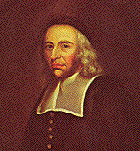
John Leverett
Harvard was never affiliated with any denomination, but its graduates often became Puritan clergymen. In 1708, John Leverett became the first president who was not a clergyman marking a turning away from Puritanism to move secular education.
Harvard and other Ivy League colleges and universities began separating themselves from their sponsoring churches in the late 1800s and early 1900s. Harvard ousted its Calvinist board members and replaced them with Unitarians. By the end of the nineteenth century, President Charles Eliot transformed the University into a secular university with no ties to its denominational roots.
Twentieth Century Consequences
The conflict between liberal and conservative theologies continued into the twentieth century. Fundamentalists enumerated the non-negotiables of traditional Christianity, including the virgin birth of Christ, the inspiration and authority of Scripture, the substitutionary atonement of Christ, the bodily resurrection of Christ, and the historicity of miracles.
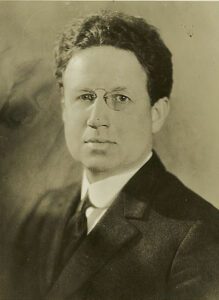
Harry Fosdick
Liberal Baptist theologian Harry Emerson Fosdick fought back by categorizing fundamentalists as intolerantly dogmatic and saying that the non-negotiables were merely one of many “theories” relating to historical Christianity.
The onslaught of liberal theology on traditional Christianity won control of mainline Protestant seminaries, denominational headquarters, and most religious publishing houses. Conservatives became a minority in mainstream religious culture.
It may be that conservative, traditional Christianity may have the last laugh as liberal churches sink into irrelevancy. Their churches are largely empty, and their coffers are bankrupt. Traditional Christianity has fared much better as it offers a stark alternative to the social gospel. People still need an understanding of sin, the need for conversion, personal piety, and belief in Scripture.
Dwindling Liberal Christianity
Liberal Christianity reduced the Christian message to everchanging doctrines and denial of many essential Christian doctrines. There are no objective moral values as adherents are encouraged to develop a theology that is “right for them.”
This has resulted in practices that would never have been considered in more traditional Christian churches, including homosexual ordination with practicing homosexual bishops. These churches failed to challenge believers to improve their lives by bringing them into alignment with traditional Christian values. Instead, they allowed individuals to determine what is “right” in their minds without recognizing any objective moral truths.
Liberal mainline denominations have become little more than social outlets and have dramatically lost people to more conservative Christian denominations. People want to be challenged to lead a better life, not just be affirmed in doing whatever they want. The power of traditional Christianity to make society a better place has been the secret of its success over the centuries.
Belief
Summary of Proving the Resurrection
Liberal Christianity is cancer to the Christian Church, reducing the church to little more than a polite social club where people affirm each others’ behavior. Its members might gather to discuss social issues and how to do good in the world. But is that the primary duty of the Christian church? Certainly, the church is tasked with caring for the poor, sick, and forgotten, but it has much more responsibility than curing social ills.
The church has lost its way by emphasizing the social gospel at the expense of traditional Christian doctrine. Congregants have shown they wish to be instructed on how to live a virtuous life and not assume worldly values.
The church must balance social needs, evangelization, personal piety, and traditional Christian doctrine.
Modern Christians assume that many historical Christian doctrines are just myths with no historical basis. The historicity of Christianity has been relentlessly attacked for the past several hundred years. The Resurrection, in particular, has been ridiculed as impossible or so unlikely that other explanations are much more probable.
But is this fair? Knowledge about the ancient world has expanded greatly since the time of David Hume. We use abductive reasoning to determine the most likely explanation for the Resurrection: a historical event or myth. Proving the Resurrection becomes possible using only extra-Biblical sources beyond a reasonable doubt.
Prosecutors use the same reasoning to determine the guilt of a murderer where no murdered body is available, where witnesses are few or have all died, and where only circumstantial evidence is available. It is still possible to prove the guilt of an offender using purely circumstantial evidence beyond a reasonable doubt.
First, the timing. Why did Christ appear exactly when he did? Christ was born during the best time in ancient history to spread his gospel. That’s the topic of the next blog.


